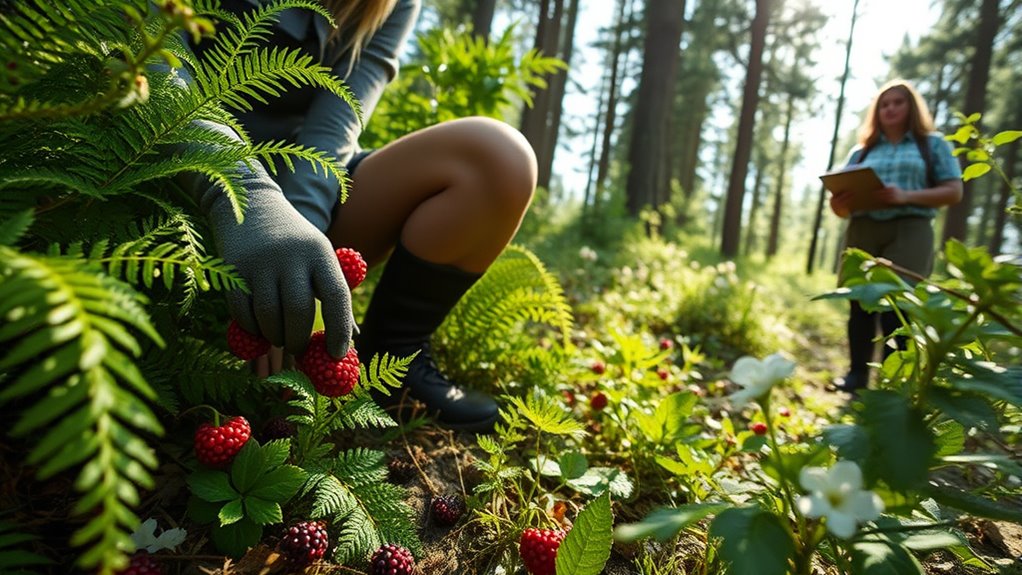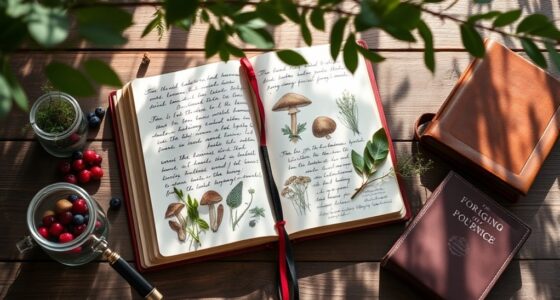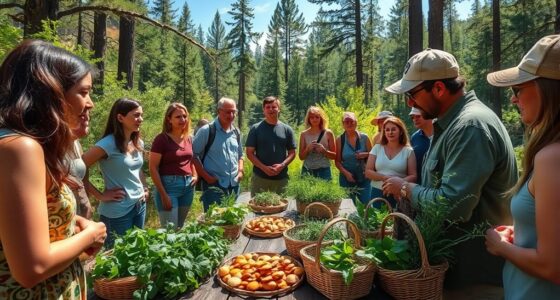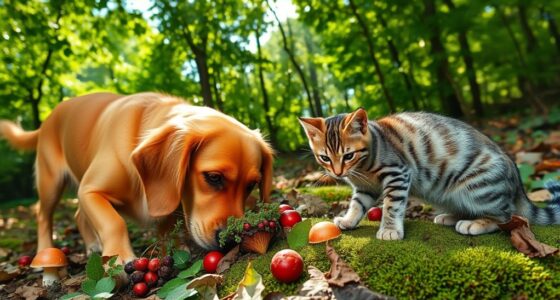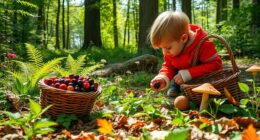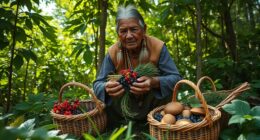When foraging, always respect private property by obtaining permission and staying within legal boundaries. Practice responsible harvesting by only taking what you need, leaving enough for plants and wildlife. Support local communities by sharing tips, participating in workshops, and following established guidelines. Follow regulations and local rules carefully to avoid legal issues. By respecting nature and others, you help protect ecosystems and promote sustainable foraging. Keep exploring to learn more about ethical harvesting practices.
Key Takeaways
- Always seek permission before entering private land or collecting plants to respect property rights.
- Harvest only what is needed, using gentle techniques to minimize environmental impact.
- Stay on designated paths and avoid disturbing wildlife or damaging vegetation.
- Share knowledge and resources responsibly, supporting community learning and conservation efforts.
- Follow local regulations and guidelines to ensure sustainable and ethical foraging practices.
Respect Private Property and Public Areas
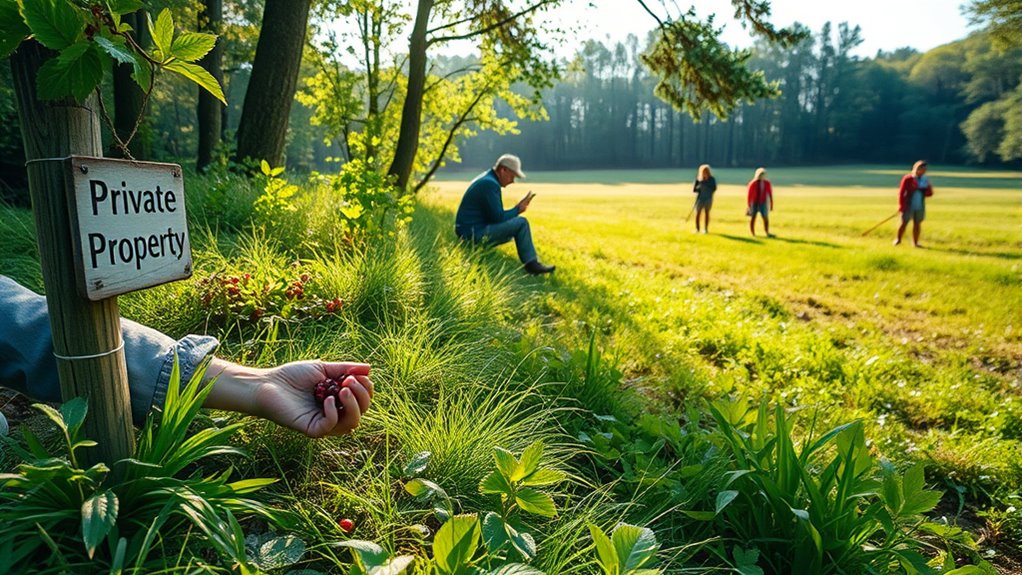
To forage responsibly, you must respect private property and public areas by obtaining permission before entering or collecting plants. Trespassing on private land without consent is illegal and damages trust.
Always seek explicit permission from landowners, preferably in writing, to prevent misunderstandings. Respect any specific rules they set, such as designated areas or harvest limits. Being aware of land ownership boundaries can help you avoid unintentional trespassing and ensure you stay within legal limits. Additionally, understanding local regulations related to foraging can help you stay compliant and avoid penalties. Being aware of TikTok trends can also inform you about popular foraging practices or conservation tips shared on social media.
If you’re unsure who owns the land, do thorough research using local records or community sources before foraging. Clearly identify property boundaries to avoid unintentional trespassing. Proper knowledge of property rights can safeguard you from legal issues and promote ethical foraging.
In neighborhoods, be cautious, as access rights can be limited. Stick to designated paths whenever possible, and never force entry or damage fences, gates, or signs.
Respecting boundaries ensures you forage ethically and maintain good relationships with landowners and communities. Additionally, understanding self-watering plant pots can be helpful for maintaining healthy plants in your garden.
Practice Responsible Harvesting and Leave No Trace
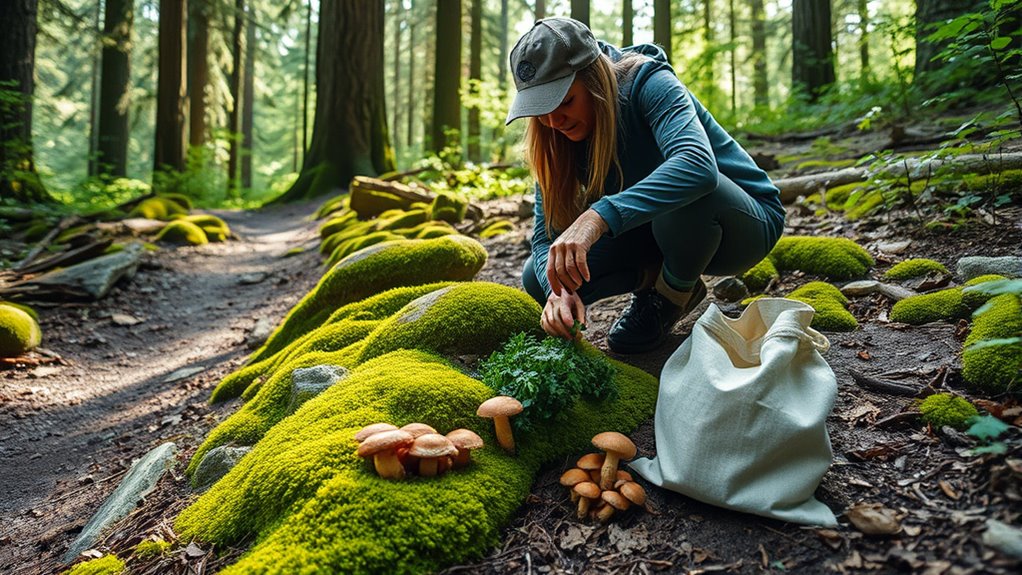
Respecting boundaries and permissions is just the first step in ethical foraging. You should harvest only what’s needed to prevent over-harvesting and allow plants to reproduce. Learning plant life cycles helps you know when and how much to collect without harming future growth. Proper identification is essential to avoid damaging protected or harmful species, and utilizing sustainable harvesting techniques ensures the environment remains healthy. Always identify plants correctly to avoid damaging protected or harmful species. Use gentle methods, like cutting herbs instead of pulling them up, to minimize harm. Follow local regulations and choose sustainable locations to protect sensitive environments. Harvest during peak times for ideal quality, and leave some plants for wildlife. Avoid trampling soil or damaging surrounding vegetation. Always remove all trash, limit foot traffic in fragile areas, and avoid disturbing wildlife, ensuring the environment stays healthy for future foragers. Being aware of sound vibrations and their effects can also promote a more harmonious interaction with nature during your foraging adventures. Additionally, understanding the cost and budgeting involved in sustainable practices can help you allocate resources effectively for ongoing responsible foraging efforts. Being mindful of regulatory compliance helps ensure your foraging activities remain within legal boundaries and support conservation efforts.
Engage With and Support Local Foraging Communities
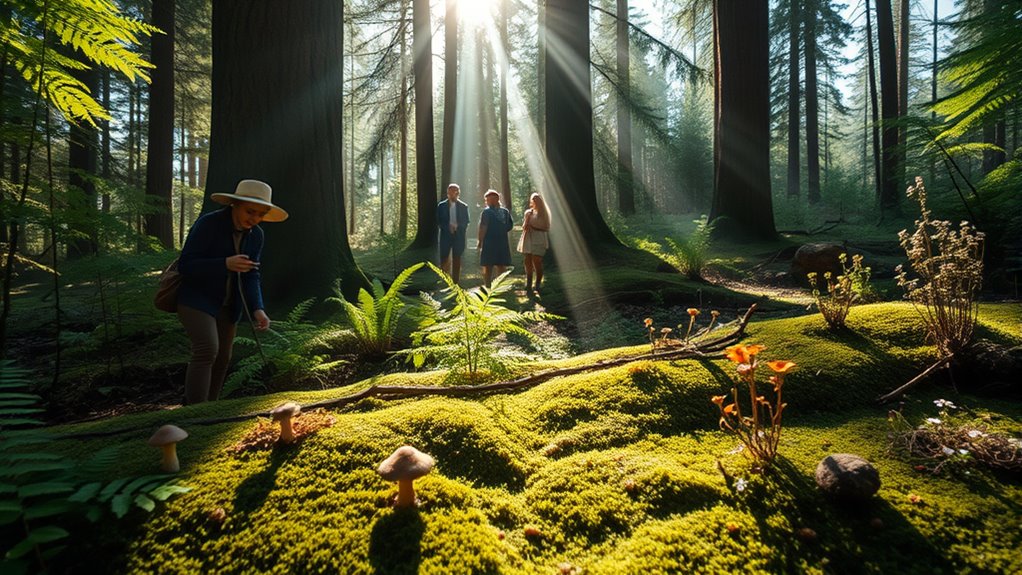
Engaging with and supporting local foraging communities strengthens both your skills and the preservation of sustainable practices. Participating in community events and workshops allows you to learn from others, share knowledge, and refine your techniques.
Using social media to exchange tips, locations, and methods builds a sense of camaraderie among foragers. Planning group forays not only uncovers new spots but also fosters relationships.
Supporting local organizations, farmers’ markets, and community gardens boosts economic and environmental sustainability. Educating others about foraging benefits encourages broader support.
Respectful communication about traditions and practices helps avoid conflicts and promotes understanding. By actively engaging, you contribute to a thriving community that values responsible harvesting, cultural respect, and shared knowledge, all of which sustain both the environment and the craft of foraging.
Follow Local Regulations and Obtain Necessary Permissions
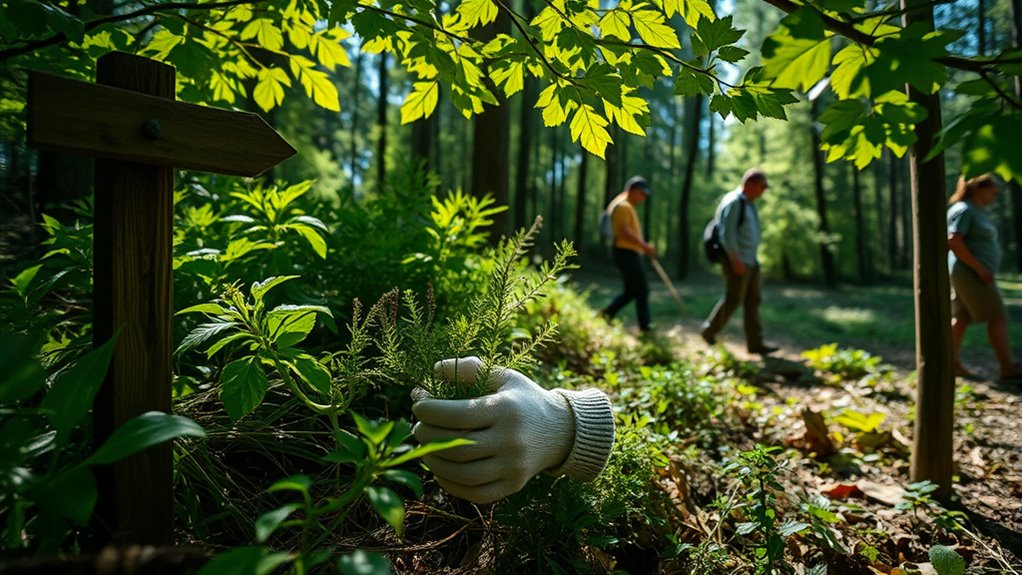
Supporting local foraging communities means you’re also responsible for adhering to the rules that protect resources and guarantee everyone’s safety. Most private lands require landowner permission before you forage, and many public lands, like National Parks, prohibit plant removal unless explicitly allowed. Park operating hours and regulations can vary, so it’s important to research specific locations beforehand. A hybrid bike can be a versatile tool for exploring diverse terrains, including areas where foraging is permitted. Regulations vary widely—for example, some states ban foraging altogether on certain lands, while others require permits to collect specific plants, fungi, or herbs. Always research local laws through official websites, ranger stations, or regulatory documents before heading out. Legal foraging practices help prevent ecological damage, preserve plant populations, and ensure your foraging remains lawful and sustainable. By understanding foraging regulations, you can better navigate the legal landscape and avoid inadvertent violations. Failing to obtain the necessary permissions or permits can lead to fines or legal trouble. Additionally, practicing ethical foraging helps ensure sustainable harvesting and the preservation of native plant populations. Complying with federal, state, and local rules helps prevent ecological damage, preserves plant populations, and ensures your foraging remains lawful and sustainable.
Share Knowledge and Promote Sustainable Foraging Practices
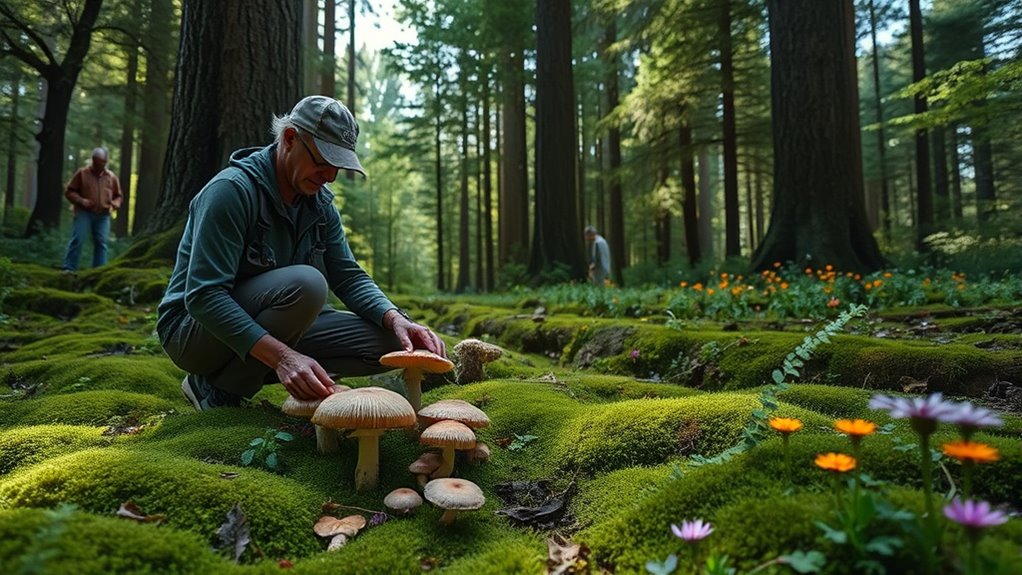
Sharing knowledge about sustainable foraging practices is essential to preserving ecosystems and ensuring that resources remain available for future generations. You should identify abundant species and prioritize non-native plants to reduce the risk of invasive growth. Always consult resources like United Plant Savers to avoid harvesting endangered plants. Incorporating ethical harvesting guidelines can further support ecosystem health and promote responsible foraging habits. Being aware of the local ecosystem and its specific needs enhances the sustainability of your foraging efforts. Understanding plant identification techniques, including seasonal variations and distinguishing edible from inedible species, is crucial for safe foraging. Developing modern foraging tools can improve accuracy and safety during foraging excursions. Stay aware of local demand to prevent overharvesting due to commercial pressure.
Organize workshops, join foraging groups, and collaborate with experts to promote ethical practices. By supporting biodiversity through selective harvesting and respecting plant life cycles, you help maintain healthy ecosystems. Additionally, understanding the best arcade machines for home game rooms can inspire you to create engaging spaces that encourage community sharing and responsible enjoyment of games. Sharing your knowledge ensures sustainable foraging that benefits both nature and future foragers.
Frequently Asked Questions
How Do I Identify Edible vs. Poisonous Plants Safely?
To identify edible versus poisonous plants, you need to carefully examine key traits like leaf patterns, berry colors, and flower types.
Use reliable resources such as field guides or consult experts, since apps can be unreliable.
Always test unfamiliar plants with methods like the Universal Edibility Test and start with small amounts.
What Are Common Signs of Over-Harvesting in an Area?
Imagine a garden where plants suddenly become sparse and stressed—that’s a sign of over-harvesting. You might notice reduced plant density, unhealthy or stressed plants, and soil compaction from repeated trampling.
Young growth may disappear, and pests or disease may increase. These signs show you’re harvesting too much, which can harm the ecosystem.
To prevent this, always harvest responsibly, leaving enough for plants to regenerate and future foragers.
How Can I Find Local Foraging Groups or Resources?
To find local foraging groups or resources, start with online platforms like Falling Fruit or Meetup.com, where you can discover or create groups in your area.
Join active Facebook groups such as Edible Wild Plants or Foragers Unite!
Additionally, check out local events, botanical gardens, or guided tours to meet experienced foragers.
Using these resources, you’ll connect with a community that shares your interest and helps you learn more about local foraging.
Are There Specific Seasons Best for Foraging Certain Plants?
Oh, surely, you’ll magically stumble upon the perfect season for every plant—like they’re just waiting to be plucked. In reality, spring is prime for greens like dandelion and fiddleheads, while summer’s ripe for berries.
Autumn offers nuts and mushrooms, and winter’s for roots. Timing varies by region and climate, so pay attention to local cues.
Happy hunting—just don’t forget to respect the plants and your fellow foragers!
How Do I Handle Encounters With Wildlife While Foraging?
When you encounter wildlife while foraging, stay calm and keep your distance.
Avoid loud noises or sudden movements, and never attempt to touch or feed animals.
Recognize signals of stress, such as growling or retreating, and back away slowly if needed.
Carry safety gear like bear spray if necessary, and always respect their space.
Conclusion
By following these foraging etiquettes, you’re like a mindful gardener tending a delicate ecosystem. Respect private property, harvest responsibly, and support local communities to make certain nature thrives for generations. Remember to follow regulations and share what you learn—every action ripples through the environment. When you practice sustainable foraging, you’re not just gathering food; you’re nurturing a shared, precious resource. Together, we can keep the wilds flourishing, like a well-tended garden that blooms forever.

